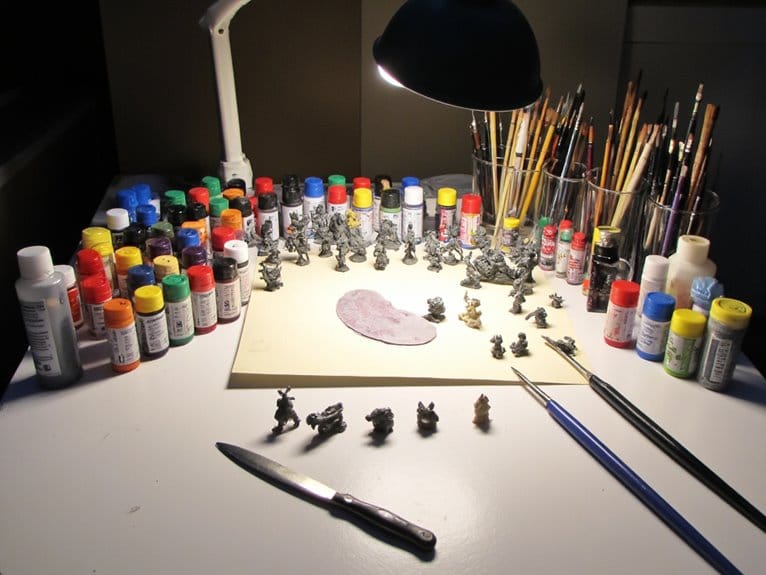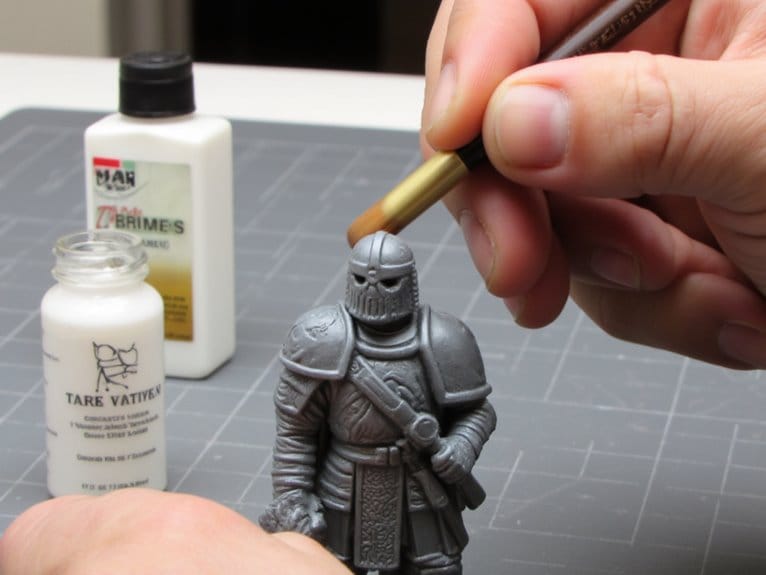We are supported by our audience. When you purchase through links on our site, we may earn an affiliate commission, at no extra cost for you. Learn more. Last update on 3rd July 2025 / Images from Amazon Product Advertising API.
Can we talk about Object Source Lighting also known as (OSL)?
Because let me tell you, it’s like injecting pure magic into your artwork. Seriously, it takes your creations to a whole new level, breathing life into every brushstroke.
Imagine the colors on your minis dancing and the shadows coming alive. It’s downright mesmerizing, isn’t it?
Now, if you’re ready to unleash your artistic freedom and dive into the world of object source lighting, you’ve come to the right place. In this article, I’m going to be your guide, walking you through all the key elements, tools, and techniques you need to perfect this technique.
So, let’s get started on this journey together, shall we?
Key Takeaways
- Color temperature and its impact on mood and atmosphere
- Light source placement and its impact on shadows, highlights, reflections, and refractions
Understanding Object Source Lighting
Understanding Object Source Lighting is achieved by studying the interaction between light and objects. When it comes to creating realistic and visually appealing lighting effects, color temperature plays a crucial role.
The choice of color temperature can completely transform the mood and atmosphere of a scene. Warm colors, like those found in candlelight or sunset, evoke a sense of coziness and intimacy, while cool colors, like moonlight or fluorescent lighting, create a more distant and sterile feeling.
It’s important to consider the color temperature of your light source and how it will interact with the objects in your scene. Additionally, there are common mistakes to avoid in object source lighting techniques, such as using light sources that are too bright or too dim, or using inconsistent color temperatures.
To effectively implement object source lighting, it is essential to consistently consider the key elements that contribute to its realistic and captivating effects.
| Key Elements | Description |
|---|---|
| Light Source Placement | Position the light source in a way that aligns with the desired effect. Consider the angle, distance, and intensity. |
| Light Source Color | Choose colors that complement the scene and evoke the desired mood. Experiment with warm and cool tones. |
| Shadows and Highlights | Use shadows to create depth and highlights to emphasize certain areas. Play with contrast for a dramatic effect. |
| Light Falloff | Understand how light diminishes over distance and adjust the falloff to create a realistic lighting gradient. |
| Reflections and Refractions | Utilize reflections and refractions to add complexity and realism to the lighting. Experiment with different surfaces. |
Can Object Source Lighting Techniques Be Used to Paint Glowing Eyes in Miniature Painting?
Yes, object source lighting techniques can be used to create convincing glowing eyes in miniature painting. By following a paint glowing eyes tutorial, miniature artists can learn how to effectively use light and shadow to make the eyes appear to emit a glowing effect that adds depth and realism to their work.
Step-by-Step Guide to Creating Object Source Lighting
I will share my step-by-step guide to creating object source lighting using a few essential tools and techniques.
- Choose the light source: Start by deciding where you want the light to come from on your miniature. This could be an object on the figure or its base, like a torch, lamp, or a sword that emits light.
- Apply the main lighting color: Begin by drybrushing the primary color for your lighting effect. For instance, Baharroth Blue works well for this purpose.
- Paint the light source: Give the light source a white undercoat to enhance the glowing effect. Then, use an airbrush to apply your chosen fluorescent color. Warpaints Air Fluo Colours are a great option for achieving OSL effects.
- Work on the surrounding area: Apply a thin, translucent layer of paint in the same color as your light source to the areas around it. If your light source is yellow, use a thin yellow glaze to paint the surrounding areas.
- Add extra highlights: Elevate the quality of your paint job by incorporating additional highlights and extreme highlights. Learn about color selection, brush choices, and other techniques for enhancing your miniature’s appearance.
- Be mindful of shadows: Avoid positioning light sources in a way that conflicts with the natural shadows cast by the miniature. No matter how vivid your lighting effect is, it can be overshadowed by the mini’s own shadows. Sometimes, adjusting the miniature’s position or filling in certain areas can help.
OSL and light effects can be challenging, but practice makes perfect. There are numerous online tutorials available to help you hone your skills in painting OSL and creating glowing effects. Keep in mind that there are no strict rules in miniature painting. The key is to experiment, have fun, and let your creativity shine through!
Here is a great video on glow effects that can come in handy.
Conclusion
As the light dances and caresses every curve and crevice, object source lighting breathes life into the inanimate, transforming it into a mesmerizing spectacle. With each stroke of the brush and careful placement of light, a masterpiece is born.
The interplay of shadows and luminosity creates a symphony of emotions, captivating the viewer’s soul. Object source lighting is a powerful tool, allowing artists to transcend the boundaries of reality and immerse themselves in a world of enchantment and wonder.



